Although most of us don’t often interact with them, penguins are unusual and adorable birds, with their entertaining antics and “fluffy” appearance. But are there different types of penguins, and what are they?
There are approximately 19 types of penguins, depending on which authority is followed. While most of these birds live in the Southern Hemisphere, one penguin type occurs in more northern regions.
Penguins come in various shapes and sizes, from gigantic emperors and kings to minute fairy penguins. While you might not know it now, penguins share several similarities; however, they also have some significant divergences.
Unfortunately, these beloved birds bear the brunt of climate change’s impacts. So to introduce these incredible bird types to you, we’ll explore the different types of penguins below and hopefully learn an interesting thing or two. Ready? Go!

What Is A Penguin?
A penguin is a flightless bird specially adapted to a marine lifestyle, their wings are modified flippers, and they are excellent swimmers.
There are six penguin genera and roughly 19 penguin species; however, scientists often argue over which subspecies should be a species themselves. Added together, we have (roughly) 278 different types of penguins.
According to the Integrated Taxonomic Information System, the various types of penguins are Chordate animals that belong to the Aves class under the order Sphenisciformes and in the family Spheniscidae.
The six penguin genera are Aptenodytes, Eudyptes, Eudyptula, Megadyptes, Pygoscelis, and Spheniscus.
Common Characteristics Of Penguins
Although there are some differences, penguins share some common features.
Penguins are flightless birds; their modified wings function as flippers, while their tails are short, stiff, and wedge-shaped. Most penguins have a black-and-white coloration.
They spend most of their time in an aquatic environment and are excellent swimmers. Penguins have powerful jaws and spiny tongues to accommodate a marine diet.
While practically all penguins live in the Southern Hemisphere (barring the Galapagos penguin), only five species live in Antarctica (and three only breed there). They are not only found in cold climates, as many believe.
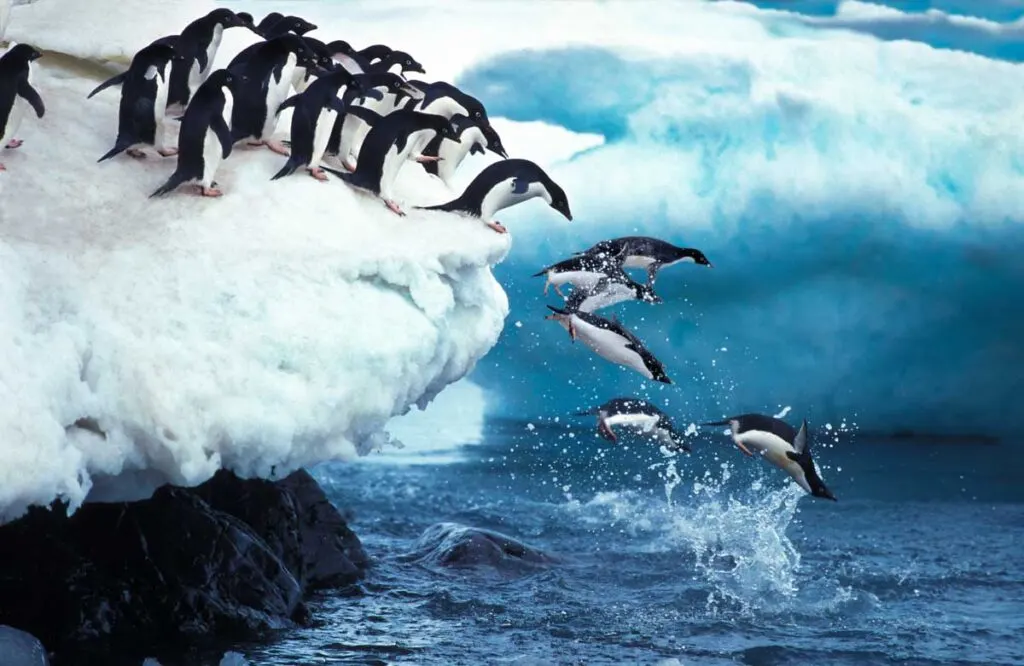
How many types of penguins are there? There are six penguin genera and roughly 19 penguin species; however, scientists often argue over which subspecies should be a species themselves. Added together, we have (roughly) 278 different types of penguins.
Penguin Types
Ornithologists divide penguins into groups based on DNA, features, geographic distribution, etc.
Below are the six different kinds of penguins.
Great Penguins
The “great” penguins are the two species that occur in and around Antarctica. They are the emperor and king penguins.
These penguins can survive in the extreme cold of the Antarctic and subantarctic regions. They generally nest in large colonies, and they live in barren areas.
Brush-Tailed Penguins
The brush-tailed penguins belong to the genus Pygoscelis and include Adelie, chinstrap, and gentoo penguins.
These types of penguins are medium to large-sized and excellent swimmers. Their group name derives from their stiff, brush-like tails, which they use as a rudder while swimming.
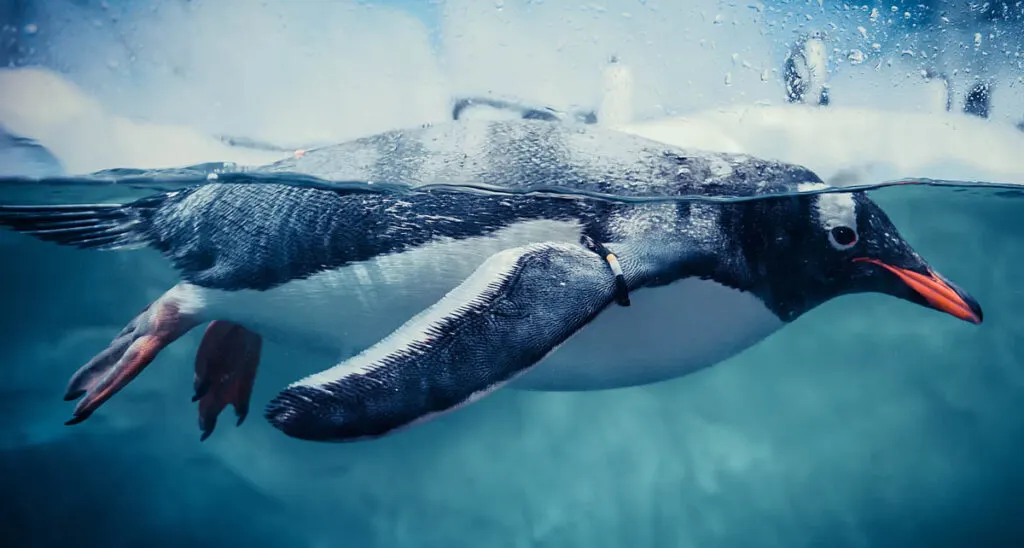
Little Penguins
All little penguins belong to the Eudyptula genus.
There are two species in this genus, the little penguin and the Australian little penguin.
All species (and subspecies) of little penguins are minute in stature. One species occurs in Australia, while the remainder inhabits New Zealand.
Although the “little penguin” is a distinct species, there are several subspecies of little penguin, including: E. minor albosignata (white-flippered penguin)
E. minor chathamensis (Chatham little penguin)
E. minor iredelai (northern little penguin)
E. minor minor (southern little penguin)
E. minor novaehollandiae (Australian little penguin) (recognized as a separate species)
E. minor variabilis (Cook Strait little penguin).
Banded Penguins
Banded penguins include all members of the Spheniscus genus. They are the African, Humboldt, Magellanic, and Galapagos penguins.
These penguins have characteristic C-shaped white feathers on the sides of their faces, bare pink fleshy patches, and a border of black feathers on their chest, “framing” their white belly and chest, creating a white and black band.
Yellow-Eyed Penguins
Yellow-eyed penguins are unique. They have pale-yellow eyes with yellowish plumage on their faces. They belong to the genus Megadyptes, and the M. antipodes is the only species.
The other species was considered extinct in 2009.
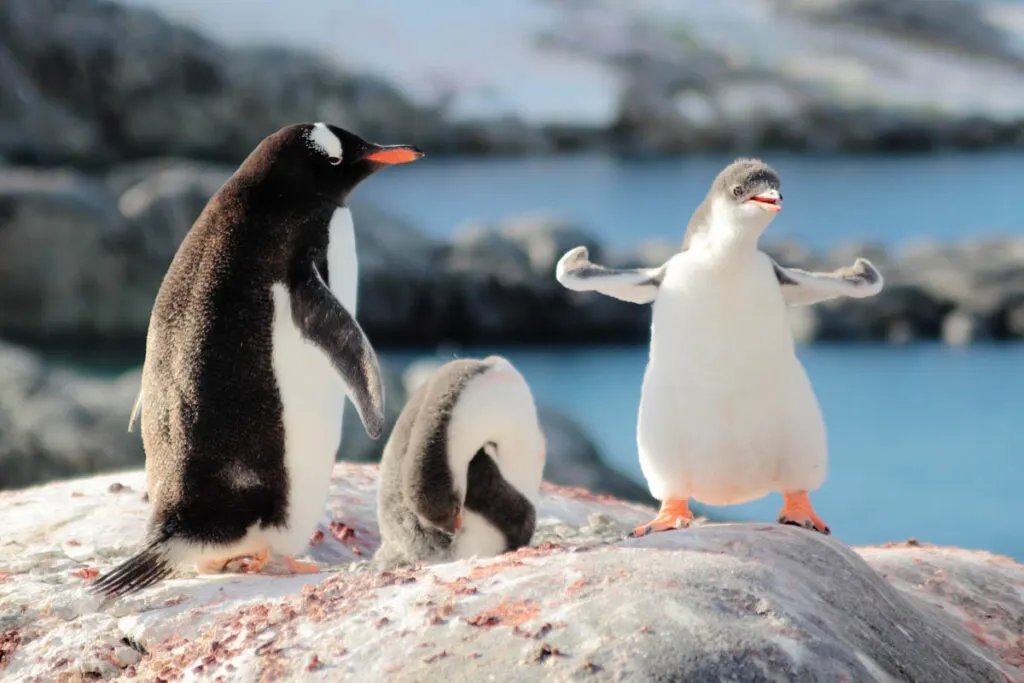
Crested Penguins
The crested penguins encompass all species under the Eudyptes genus, including southern rockhopper, macaroni, northern rockhopper, Fiordland, snares, royal, and erect-crested penguins.
Their characteristic feature is a plume of yellow or yellow-orange feathers that extends from the bill, over the eyes, to the back of the head.
However, the macaroni and royal penguin’s crests start at the forehead. They also have striking red/orange bills.
They are a widespread penguin type and range from small to large birds.
All 19 Types of Penguins
Below we examine all types of penguins in more depth. For organization purposes, this article is divided into penguin types, as explained above. Enjoy!
The 2 Great Penguins
King Penguin
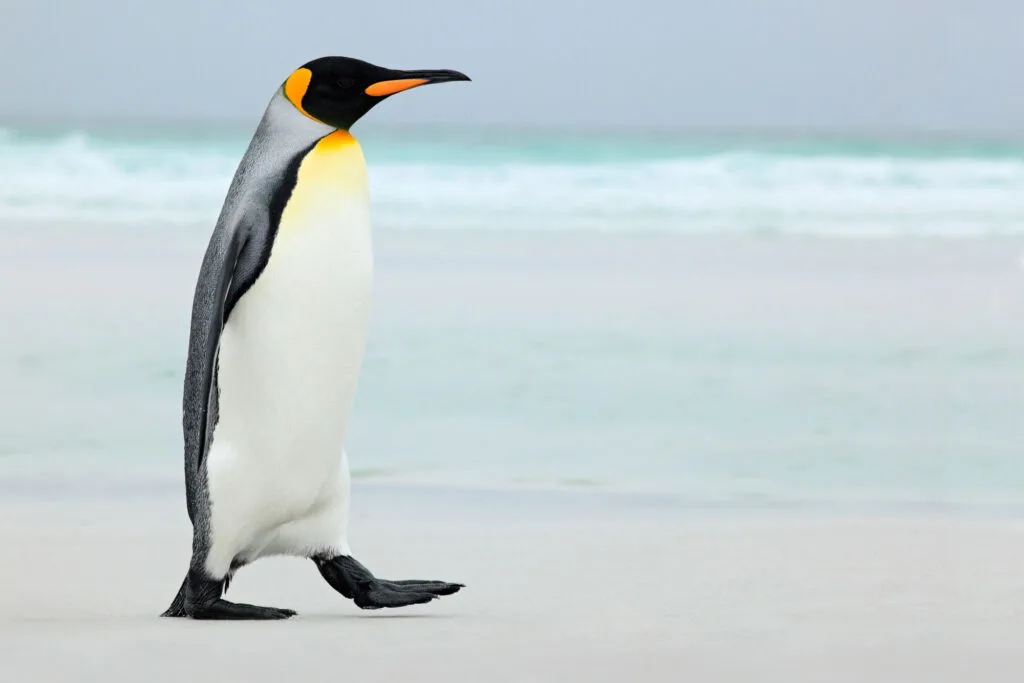
The king penguin (Aptenodytes patagonicus) is a large bird (33 to 37 in and between 30 and 35 lbs.) with a black back, chin, and throat.
They have white bellies, distinct tear-shaped orange markings on their ear regions, and orange coloration on their chests. They have long black bills with orange markings.
They strut about with an upright posture in a “dignified” manner. Their primary food is fish (lanternfish, barracudinas, and escolars); they also eat crustaceans and squids.
These birds live for roughly 26 years (up to 41 in captivity). There are two populations in Antarctica and Sub-Antarctic Islands. One population is in the Falkland Islands, South Georgia, and South Sandwich Islands.
The other population inhabits the Crozet Islands, Kerguelen Islands, Heard and McDonald Islands, Macquarie Islands, and Prince Edward Islands. Their preferred habitat is tundra (sparse vegetation and access to pelagic waters.
These highly gregarious birds (colonies of up to 39,000 birds) spend most of their time swimming. While their offspring are young, parents carry them on their feet.
Listed as “least concern,” they are the second-largest penguin type. They are also one of two species of penguins that don’t build nests. Also, they are monogamous and mate with only one mate per season, but they don’t mate for life.
Some scientists divide these penguins into two subspecies: Aptenodytes patagonicus patagonicus and A. patagonicus halli; however, not everyone agrees on this division.
Their predators include leopard seals and orcas.
Emperor Penguin
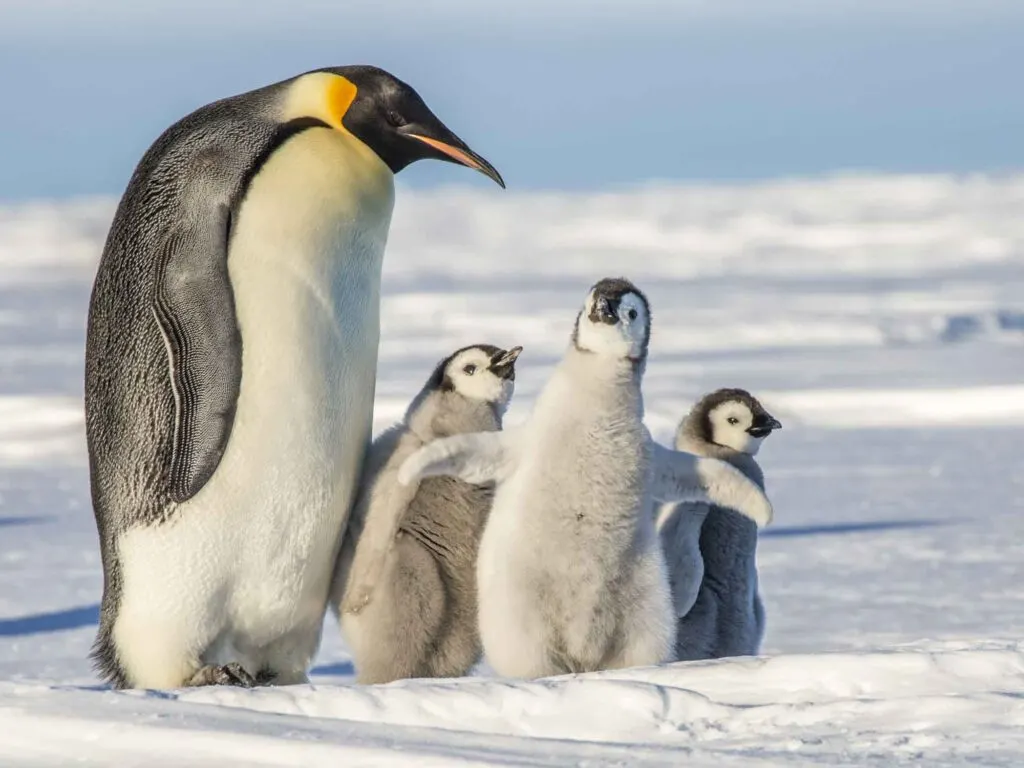
The emperor penguin (Aptenodytes forsteri) is a large flightless bird that resembles the king penguin.
They have black heads and white necks, with faint orange hues on their necks and chests. These are the largest penguin species ranging between 45 to 50 inches tall and weighing 55 to 100 lbs.
They predominantly eat fish, krill, and squid and live between 15 and 20 years (up to 34 in captivity).
Their range includes ice shelves and coastline areas in Antarctica and subantarctic islands (Islas Malvinas, Tierra de Fuego, and Isla de Los Estados).
Mostly found in large colonies on tundra and ice deserts, these birds frequent pelagic waters to hunt along ice edges, where they dive to 1800 ft for 22 minutes in search of food.
These penguins are listed as “near threatened,” and they are one of two that “live” in Antarctica.
Emperor penguins live in areas that reach -76°F (wind chill). They survive by “huddling” in groups to stay warm and “tagging out” as needed. These huddles range from 200 to 6,000 birds and may last up to 1.6 hours. Aside from the cold, they are prey for leopard seals and killer whales.
Did you know? Most penguins lay two eggs in a clutch, although the two largest species, the emperor and the king penguins, lay only one.
The 3 Brush-Tailed Penguins
Adélie Penguin
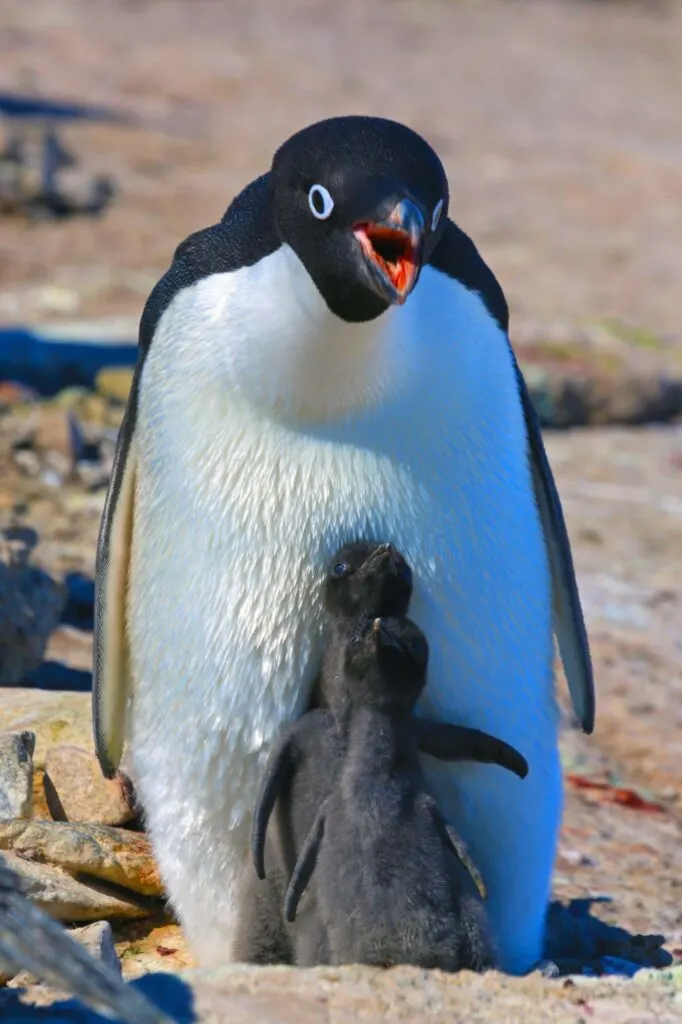
Adélie penguins (Pygoscelis adeliae) are medium-sized (between 28 and 29 in and weighing 9 to 13 lbs.) water bird species with black heads and backs, white chests, and short beaks.
They have a distinctive ring of white feathers around each eye. These penguins also have a small crest.
Their diet consists primarily of krill (Euphausia superba and E. crystallorophias); however, they also eat Antarctic blennies (Pleuragramma antarcticum) and squid. This penguin breed is considered as “least concern” on the IUCN Red List.
These penguins live between 11 to 20 years and occur on the Antarctic coast and on subantarctic islands (including South Orkney, South Sandwich, South Shetland, and Windmill Islands). During the summer, they occupy rocky ice-free coastlines in Antarctica.
Conversely, during the winter, they move north to forage in the open sea, close to pack ice.
These penguins are excellent swimmers, diving up to 560 ft to forage and swimming between 2.5 and 5 mph (they can only waddle at around 1.6 mph).
Scientists estimate that they travel up to 746 mi between breeding and feeding grounds but probably closer to 185 mi more regularly).
These penguins were named by the French explorer Jules Dumont D’Urville, who discovered this species in 1840 and named them after his wife, Adéle.
They are the other penguin type that lives in Antarctica.
Chinstrap Penguin
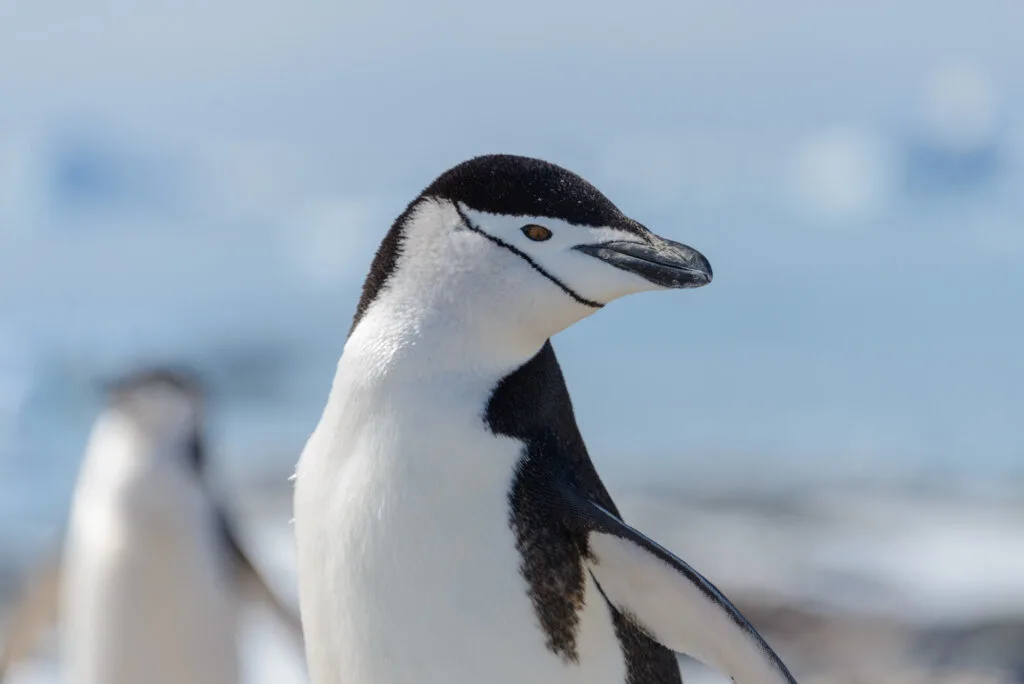
The common name of the chinstrap penguin (Pygoscelis antarcticus) comes from the characteristic black line under its chin that moves along its cheeks to the back of its head.
This chinstrap with the black plumage on top of its head looks like they are wearing a hat.
They have white chins, cheeks, bellies, and a ring of black feathers around each eye.
These penguins grow between 28 and 30 in. and weigh 7 to 13 lbs. They have a life expectancy of 15 to 20 years. Up to 99% of a chinstrap penguin’s diet is krill (Euphausia superba), while they consume fish and crustaceans in smaller amounts.
While feeding, these penguins dive between 150 and 165 ft. In extreme cases, these penguins may dive to 330 ft.
These penguins inhabit large icebergs and open oceans in the Northern areas of the Antarctic Peninsula.
They also occupy several Antarctic regions and subantarctic islands, including Balleny, South Orkney, South Sandwich, and South Shetland Islands.
These relatively aggressive penguins often fight other species. However, they are listed as “least concern,” and leopard seals are their most significant predators.
Although they don’t live in Antarctica, they are one of three types of penguins that breed in the northern regions.
At roughly 7.5 million breeding pairs, they are the second most abundant penguin types.
Gentoo Penguin
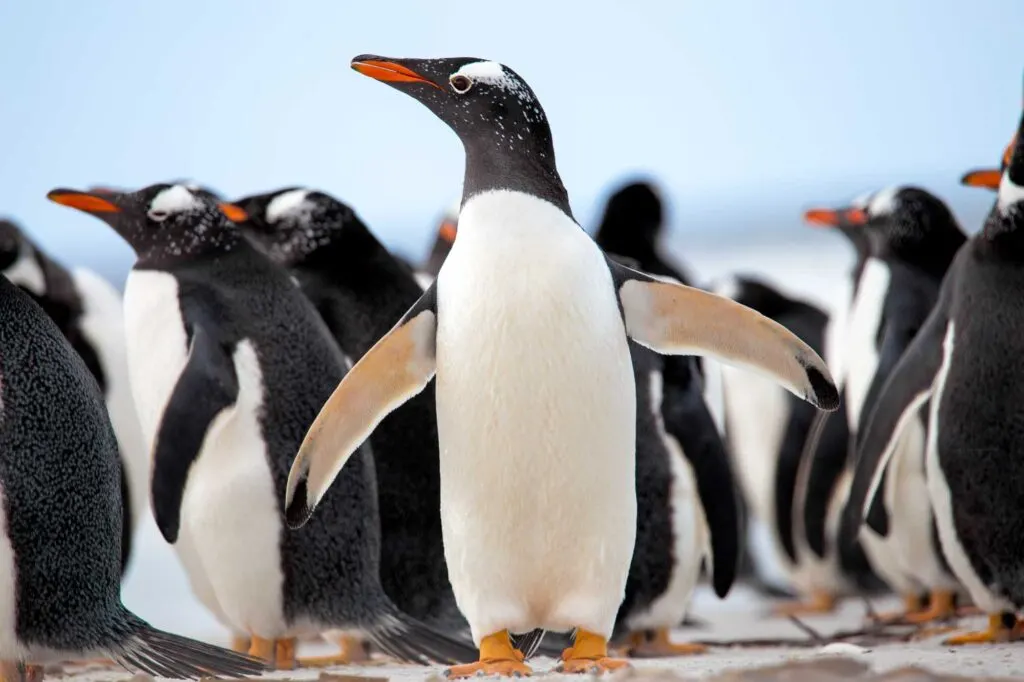
Distinguished by a white stripe across its head from eye to eye, the gentoo penguin (Pygoscelis papua) is the third-large penguin species (30 to 37 in).
They have black backs and heads, with bright orange beaks and feet. They also have white bellies and chests.
Gentoo penguins weigh between 11 and 19 lbs. Their diet consists of fish, cephalopods, krill (Euphausia), and other crustaceans.
Living between 15 and 20 years, these birds live in Antarctica and subantarctic islands, where they build nests on ice-free, grassy, or rocky areas (one of three penguin species that breed in the northern regions of Antarctica).
These social birds are “near threatened,” and many remain close to their island homes. Predators include South American sea lions, Weddell and leopard seals, and orcas.
Gentoos have two subspecies according to distribution. In the Atlantic Ocean, Pygoscelis papua papua inhabits the Falkland, South Georgia, and South Sandwich islands, the Crozet and Kerguelen islands in the Indian Ocean, and (in the Pacific Ocean) Macquarie Island.
P. papua ellsworthi occurs on the Antarctic Peninsula and surrounding islands.
Gentoo penguins reach up to 22 mph speeds in the water, making them the fastest birds underwater, and they dive to between 560 and 660 ft.
The 2 Little Penguins
Little Penguin
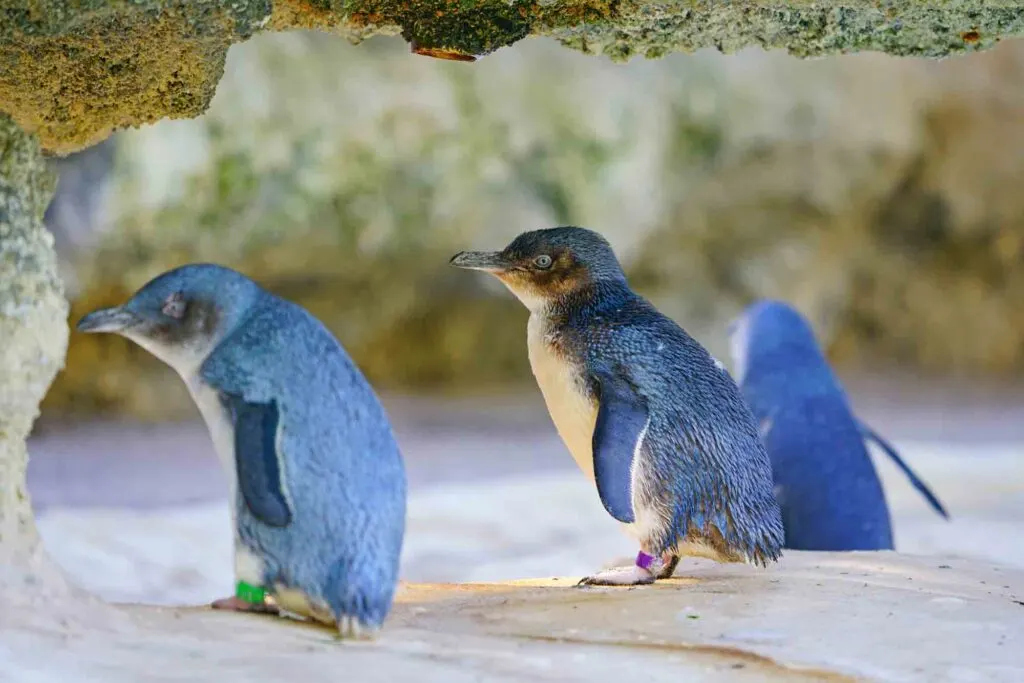
The little penguin (Eudyptula minor) is called the fairy or the little blue penguin. As its name implies, these types of penguins are the smallest of the penguin types.
They are 10 to 12 inches tall with a blue (indigo)-to-dark gray coloration on the top of their heads, backs, necks, and flippers.
They have a white belly, chest, and chin.
Little penguins weigh between 2.2 and 3.3 lbs. and primarily eat fish (anchovies and sardines), krill, squid, and other crustaceans. Although their average lifespan is around seven years, they may live up to 21.
Although there is only one species in the Eudyptula genus, there are six subspecies (E. minor albosignata, E. minor chathamensis, E. minor iredelai, E. minor minor, E. minor novaehollandiae, and E. minor variabilis).
Their total range includes Australia (southern coasts), New Zealand (eastern and southwestern coasts), Tasmania, and surrounding islands (including Brush, Montague Phillip, and Tollgate Island).
These penguins occupy coastal vegetarian/scrub and forests, savanna, rocky terrain, sandy beaches, and the open ocean. They are social penguins that nest in burrows.
Little penguins are prey for fur seals, sharks, and orcas. They are also prey for eagles and many land predators.
To avoid being eaten, these penguins congregate on the beach in “rafts” and then head back to the nesting area after foraging.
Australian Little Penguin
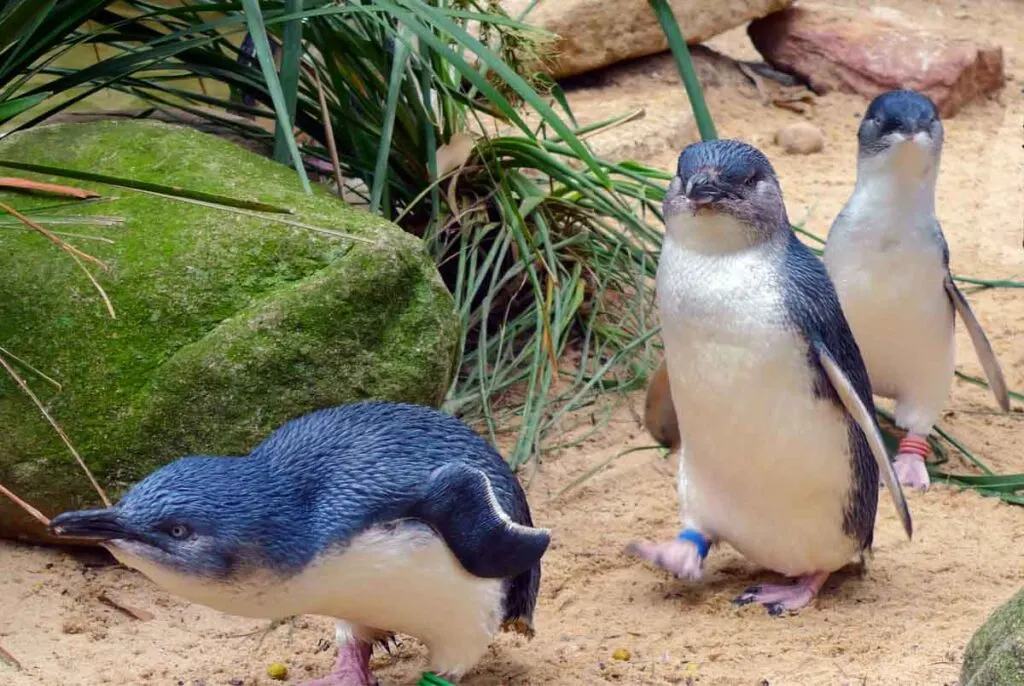
The Australian little penguin (Eudyptula novaehollandiae) was originally a subspecies of the little penguin (Eudyptula minor novaehollandiae); however, a study in 2016 determined that these penguins are a separate species.
While they resemble other little penguins and eat the same prey, the delineating factor is that these are endemic to Australia (while the other little penguins live in New Zealand and surrounding islands), where they utilize the same habitats.
Many sources do not recognize the Australian little penguin as a distinct species but hold it as a subspecies. However, some evidence supports at least 2 “clades” in the genus.
They are the only species that breed on mainland Australia.
The 4 Banded Penguins
Magellanic Penguin
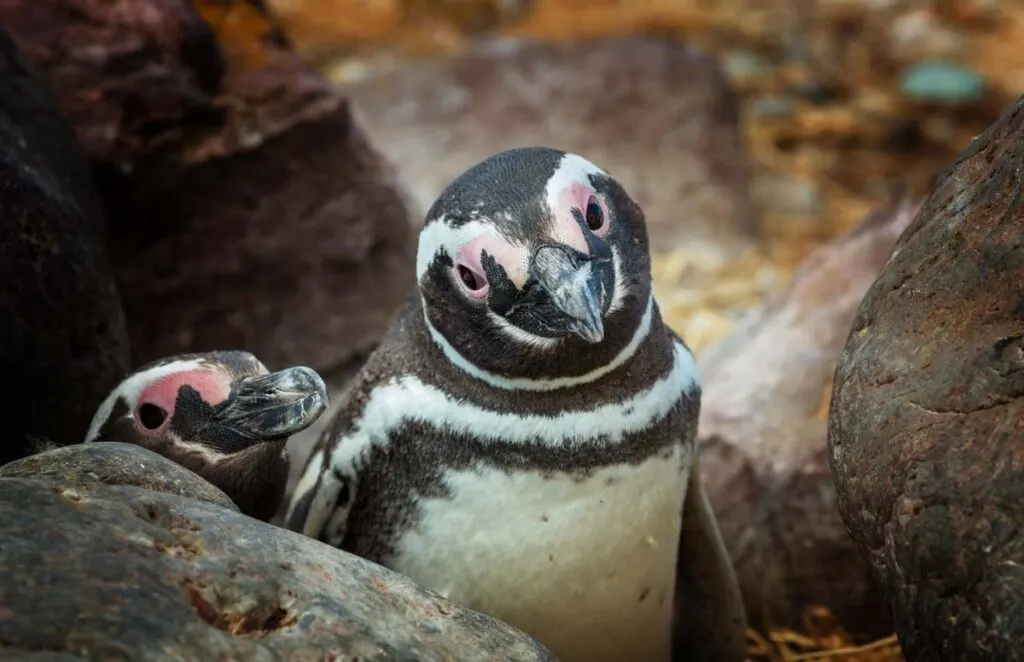
Named after the Portuguese explorer who discovered them, Ferdinand Magellan, the Magellanic penguin (Spheniscus magellanicus), has a black back, face, and head.
They have a characteristic crescent of white feathers from above their eyes to under their chins and a collar of black feathers and pink flesh around their eyes.
These penguins grow between 24 and 30 in. and weigh 8 to 14 lbs. (the largest of the Spheniscus genus). Their diet is primarily fish (sardines, anchovies, and hake), but they also eat cephalopods and krill.
Although they may reach 35 years in captivity, their usual life expectancy is 10 to 20 years.
The distribution of Magellanic penguins is the Falkland Islands and the Pacific and Atlantic coasts of southern South America (and surrounding islands), where they occupy coastal forests, scrub, grasslands, and rocky shores.
Many birds migrate north for the winter, and (while not common) some individuals travel as far as the Antarctic Peninsula, Australia, Brazil, New Zealand, and Peru.
These “near threatened birds” are excellent swimmers and dive to 300 ft while foraging. Predators include orcas, sea lions, fur seals, and several land-based predators (foxes, dogs, cats, etc.).
Humboldt Penguin
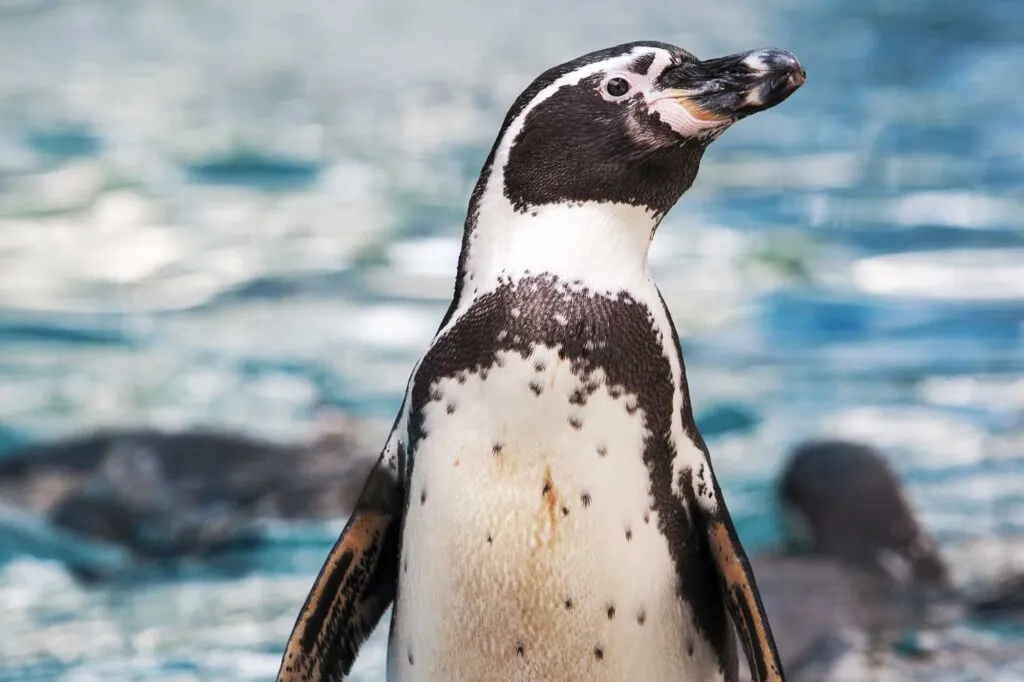
The Humboldt penguin (Spheniscus humboldti) resembles the Magellanic and African penguins.
While they share crescent-shaped face markings, the black border on their chest and bellies are thicker. They have pink flesh on their faces that extends from the bill to the eyes and much thicker beaks.
These penguins grow between 26 and 28 in. and weigh 9 to 11 lbs. Their diet primarily consists of fish (anchovies, sardines, and herring), but they also eat crustaceans and cephalopods.
Humboldt penguins live in Chile, Peru, and the surrounding Pacific Islands, reaching up to 20 years. Some populations migrate up to 621 mi north after their molt.
Their preferred habitat is rocky outcroppings and slopes with coastal vegetation and coastal/pelagic waters, where they dive 200 to 500 ft while foraging.
These penguins nest in burrows or guano deposits, which was a significant cause for the population decline from the mid-1800s (guano harvesting operations for fertilizer, destroying the penguins’ nests). These penguins are vulnerable species.
These penguins depend on cold water moving up from the Antarctic in the Humboldt Current.
Did you know? Of all the collective nouns for animals, the collective nouns for birds are the most curious ones. A group of penguins is called a colony of penguins!
Galápagos Penguin
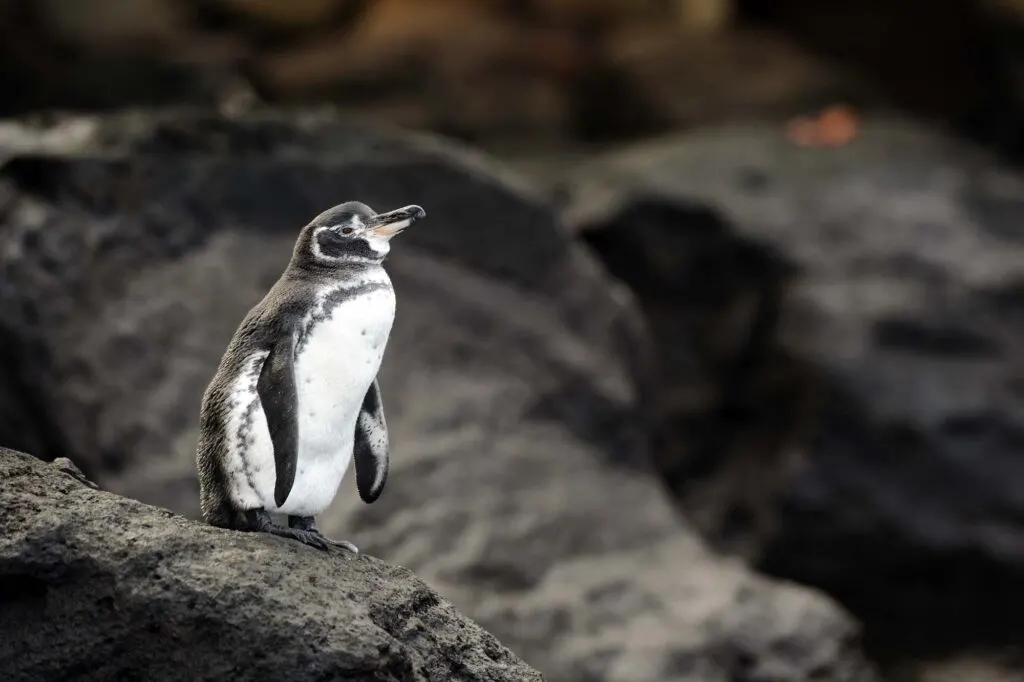
The Galápagos penguin (Spheniscus mendiculus) shares the typical crescent-shaped white markings stretching from the chin around the ears to above the eye of the different types of penguins in this genus.
These penguins have black backs, heads, and borders on their chest and bellies, breaking the white underside. They grow to roughly 21 in and weigh between 4 and 6 lbs. (the smallest of the South American penguins).
Galápagos penguins eat sardines, mullet, and small crustaceans, which they hunt in groups.
These endangered penguins are Endemic to the Galápagos islands by Ecuador (most breeding occurs on Isabela, Fernandina, and Santa Cruz Islands), where they inhabit coastal areas, like rocky shores and coastal forests.
Galápagos penguins have the smallest populations and are heavily reliant on cold water. During warmer years, fewer nutrients result in less plankton and fish. The penguin population follows the same decline.
Predation from introduced animals (rats and cats) and disease also pressure the penguin population.
These are the most northerly distributed of all penguin types. Although they are close to the equator, they prefer the colder waters brought up on the Cromwell Current from Antarctica. They also hide in caves to remain cool.
African Penguin
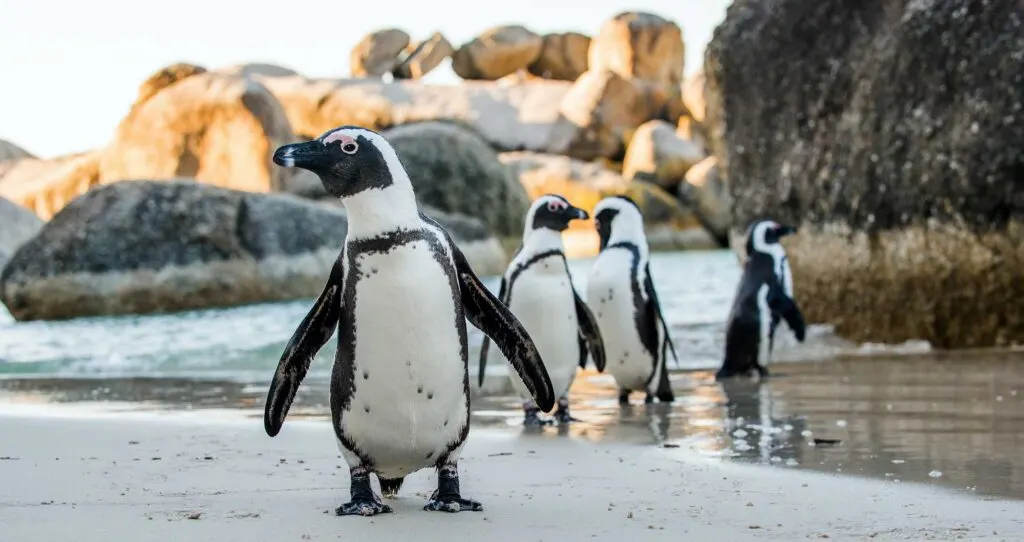
The African penguin (Spheniscus demersus) looks like the other types of penguins in the genus. However, its white crescent shape marking is significantly larger, leaving less of a black cap on their heads.
They have bare pink flesh between their eyes and bill, a black mask, back and border on their chest and belly, breaking the white underparts. They grow between 24 and 27 in and weigh 4.4 to 11 lbs.
These birds live up to 21 years and eat small fish (sardines, anchovies, horse mackerel, and herring), squid, and small crustaceans, which they hunt in groups or solitarily at depths of around 260 ft.
Endemic to southern Africa, they occupy coastal areas (rocky shores, sandy beaches, and coastal scrub), pelagic waters, and offshore islands. These penguins travel between 12 and 25 mi from the colony for food.
Competition over food sources, habitat transformation for housing, destruction of nesting sites, and oil spills threaten their survival and afford African penguins a “vulnerable” status. Fur seals, sharks, orcas, leopards, mongooses, and feral cats eat them.
The bare skin on these and other types of penguins in the Spheniscus genus helps the penguins cool down in warmer climates.
Blood circulates past these “thermal windows” through veins close to the skin. The blood cools and circulates back into the penguin’s body, cooling the bird (like a car’s radiator).
Other methods used to cool off include panting and spreading their wings to allow air to pass over more of their body.
The One and Only Yellow-Eyed Penguin
The Waitaha penguin, which also belonged to this group, is unfortunately an extinct species.
Yellow-Eyed Penguin
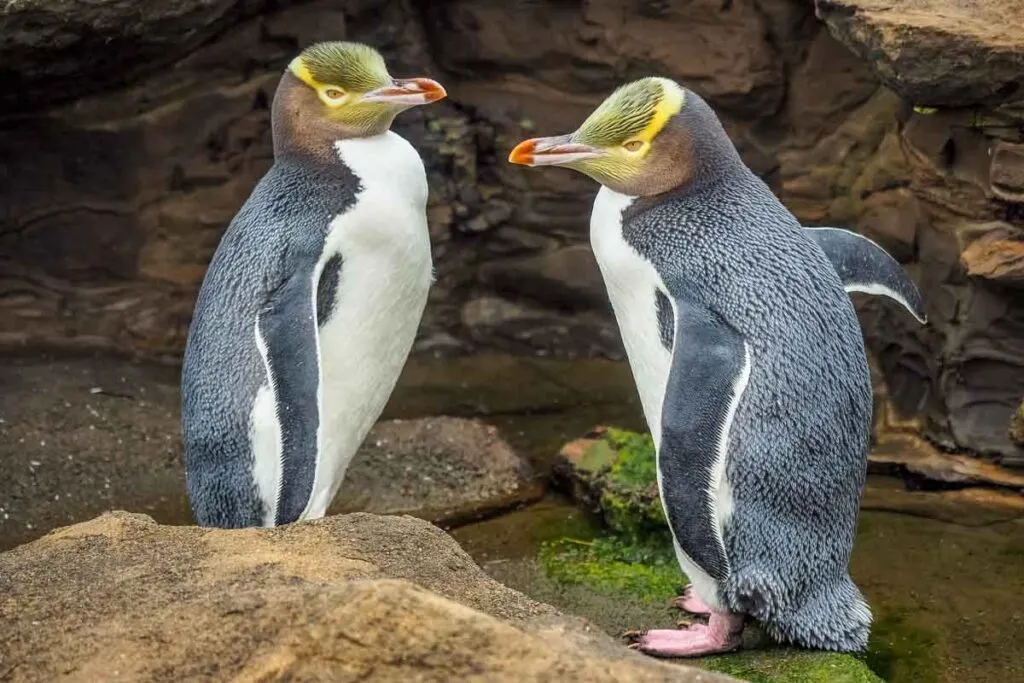
The yellow-eyed penguin (Megadyptes antipodes) is aptly named for its unique yellow coloration around their face and yellow eyes. They have gray backs, white bellies, and chests and grow between 22 and 31 in.
These penguins weigh 11 to 13 lbs. And live up to 23 years. They eat fish (bristling, red and blue cod, and smelt) and squid. While foraging, they dive to around 425 ft.
Yellow-eyed penguins are Endemic to the southeastern coast of New Zealand’s South Island and surrounding islands (Auckland, Campbell, and Stewart Islands), where they occupy coastal forests and scrubs. These penguins are not colony breeders, preferring isolated burrows.
With roughly 1500 breeding pairs, they are considered “endangered.” Threats include entanglement in fishing lines, predation by introduced species (cats and dogs), and diseases. Their habitat requirements also restrict this species.
Predators include sharks and Hooker’s sea lions, ermines, and ferrets.
The 7 Crested Penguins
Fiordland Penguin
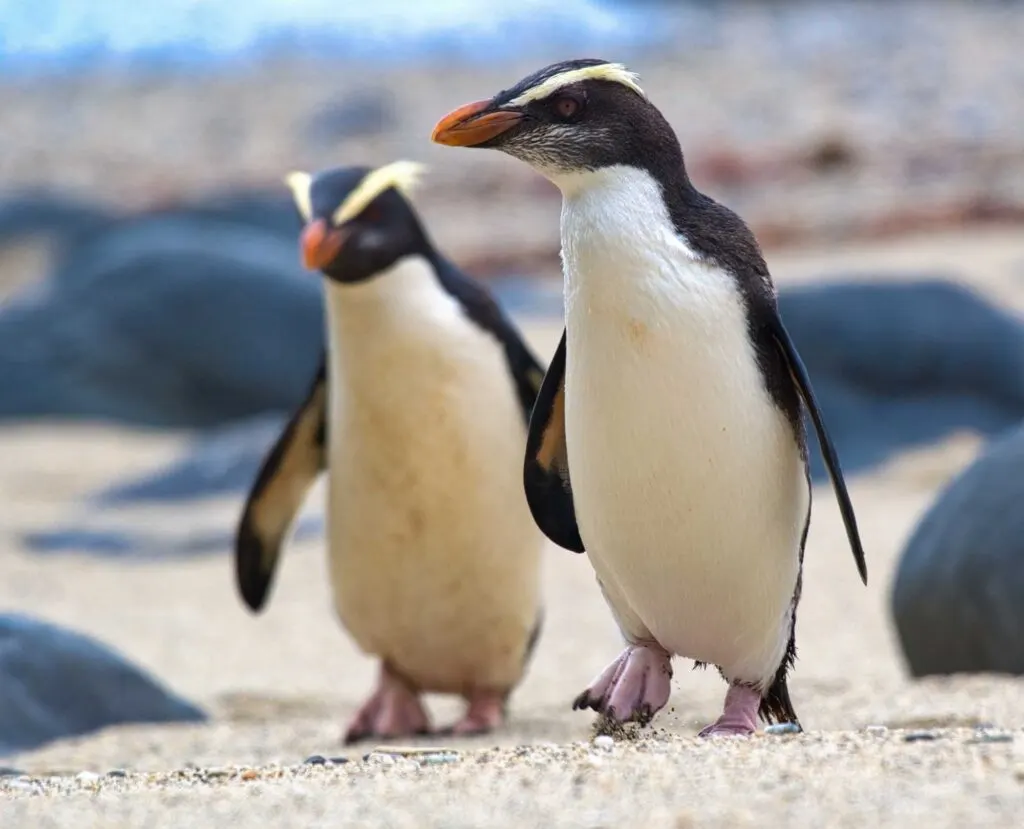
The Fiordland penguin (Eudyptes pachyrhynchus) is a type of crested penguin.
Their diagnostic feature is a thick stripe of yellow feathers that starts by the bill and extends backward past the eyes into plumes that stick out past the back of the head. They also have a bare skin patch close to their bill.
Their back and head have blue-black feathers and a white belly and chest.
Fiordland penguins were named after “Fiordland” on the western tip of South Island, New Zealand. They are roughly 22 in, weigh 9 lbs., and live between 10 and 20 years.
Their diet consists of small fish (and larvae), cephalopods, krill, and other crustaceans.
These penguins are Endemic to the western and southern coasts of South Island, New Zealand. They are also on Stewart and Solander Islands, where they inhabit coastal forests/scrub and pelagic waters.
These penguins build nests in sheltered locations, away from other nests.
Listed as “vulnerable,” the major threats include introduced predators and habitat destruction/loss (particularly of nesting sites). There are between 2,500 and 3,000 breeding pairs.
They are often prey to Hooker’s sea lions, dogs, cats, wekas (a bird), and ferrets.
Snares Penguin
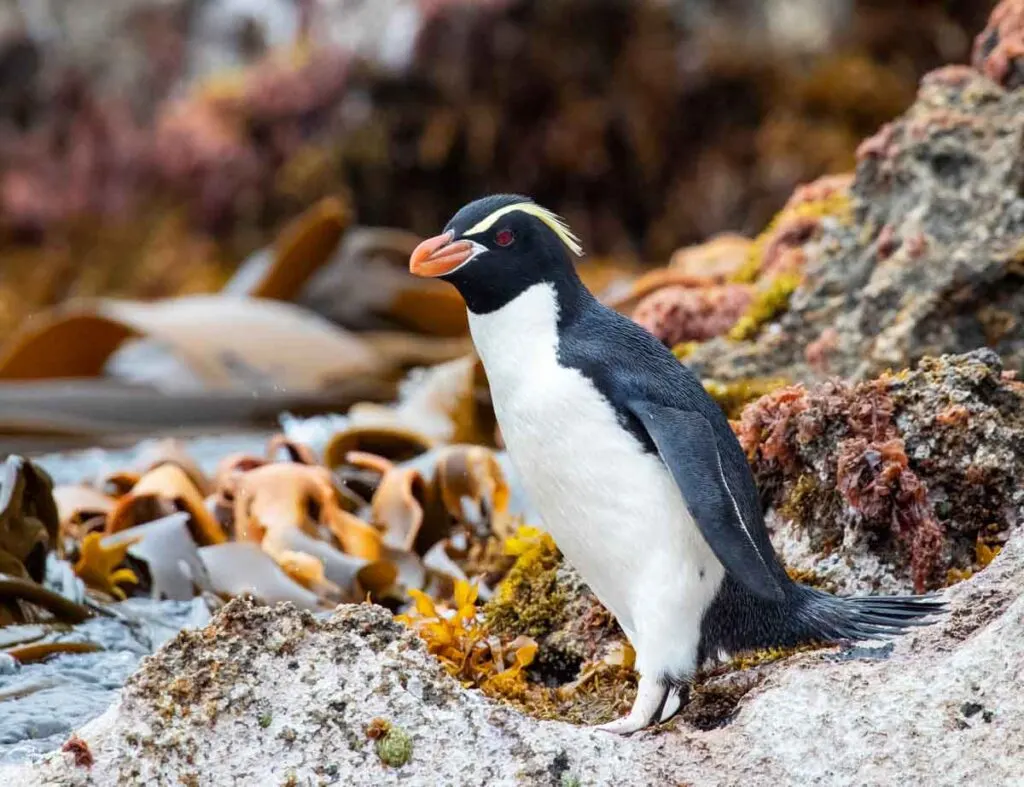
The Snares penguin (Eudyptes robustus) is another crested penguin with prominent yellow plumes (superciliary stripes) stretching from their bills, over their eyes, to the back of their heads.
The Snares penguin’s plumes are longer and hang further off the back of their heads.
They have a thick, cone-shaped orange bill framed by white/pink skin. Their back, head, tail, and wings are black, with a white chest and belly.
Weighing between 7 and 9 lbs., these penguins eat primarily krill; however, they consume fish and squid too. Living up to 20 years, they are between 15 and 24 inches.
Snares penguins breed on Snares Island and construct nests under tall tree daises or rocky slopes. They nest in colonies of up to 1500 breeding pairs.
These penguins are excellent swimmers (reaching roughly 15 mph) who migrate to Australia and the Falkland Islands. Their preferred habitat includes coastal forests, scrub, and pelagic water.
Listed as “vulnerable,” these penguins have a limited breeding range and are sensitive to disturbances.
The intensive nesting behavior (excavating and the guano build-up) results in the birds moving nesting locations frequently (a different part of the forest).
Introduced predators also pressurize the population. Hooker’s sea lions are significant natural predators.
Erect-Crested Penguin
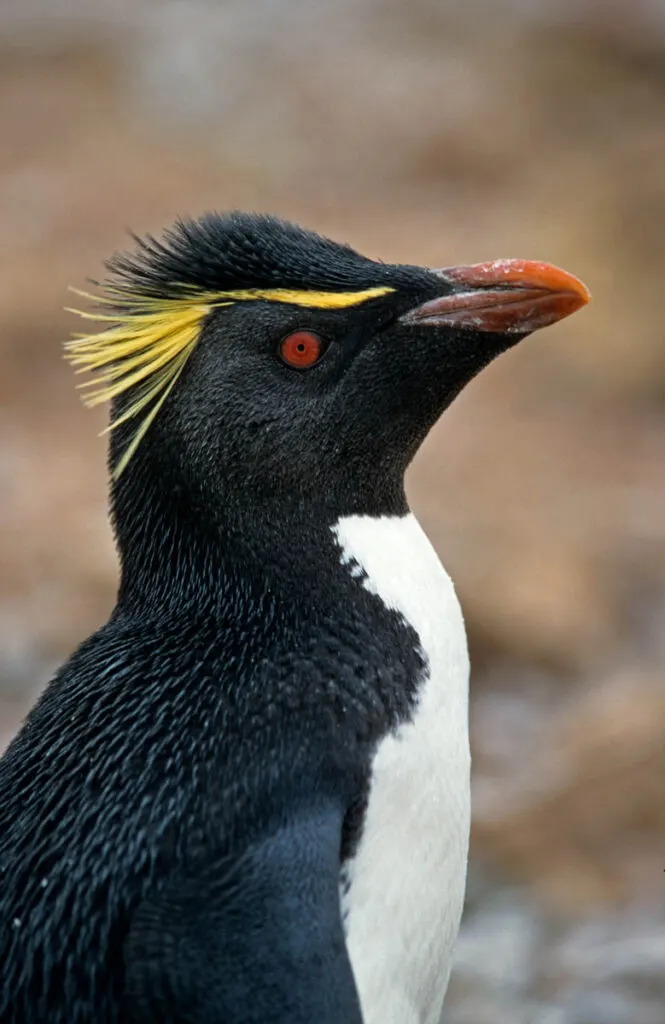
The erect-crested penguin (Eudyptes sclateri) is, as the name implies, a crested penguin. Similar to most other crested penguins in appearance, the erect-crested penguin’s yellow head plume “stands up.”
Their backs, heads, tails, and wings are black, with white underneath. They grow to 26 in and weigh around 13 lbs. and are the largest of the crested penguins. Although their diet is unknown, experts presume they eat krill, squid, and small fish.
These penguins breed in large colonies on Antipodes Islands and Bounty Islands, near New Zealand, where females congregate in rocky areas.
They usually forage around Australia, New Zealand, and surrounding islands (Auckland, Campbell, and Macquarie Islands). However, these migratory birds swim as far as Antarctica and South America, hunting food and storing fat for the winter.
They inhabit coastal vegetation, beaches, rocky shores, and pack ice.
Erect-crested penguins are “endangered.” Although more information is required, climate change and human competition over food sources are significant threats. They are a common prey item for Hooker’s sea lions.
Southern Rockhopper Penguin
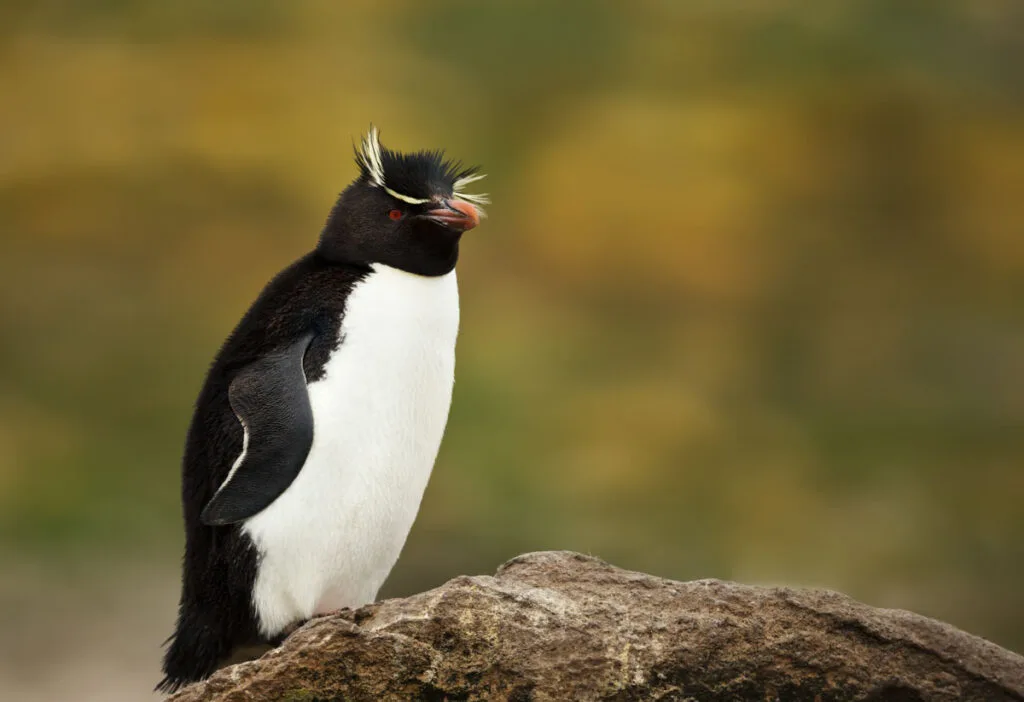
The southern rockhopper penguin (Eudyptes chrysocome) is also part of the crested penguin category. Their yellow plumes are relatively thin, but just behind the eyes, the feathers flare out dramatically.
They have a blue-black head, back, tail, and wings, with a white belly and relatively thick bills. These are the smallest crested penguins growing between 20 and 22 in and weighing 4.4 to 6.6 lbs.
Diving to 330 ft, they primarily eat krill; however, they consume cephalopods, crustaceans, and small fish. These penguins live on rocky shorelines, where (as their name suggests) they “hop” across rocks instead of politely waddling around.
Although “vulnerable,” these penguins have a large range, including the Falkland Islands, the southern coast of South America (near Cape Horn), Prince Edward and Marion Islands, Crozet Islands, Kerguelen Islands, Macquarie Island, and Campbell Island.
Southern rockhopper penguins are social birds, and breeding sites may have up to 130,000 breeding pairs.
At one point, the rockhopper penguins were various subspecies until DNA and other studies confirmed that there are at least two distinct species, the northern and southern species. The eastern and western rockhopper penguins are subspecies of these penguins.
Threats include climate change, depleted fish stocks, and pollution. Predators include leopard seals, southern fur seals, and southern sea lions.
Northern Rockhopper Penguin
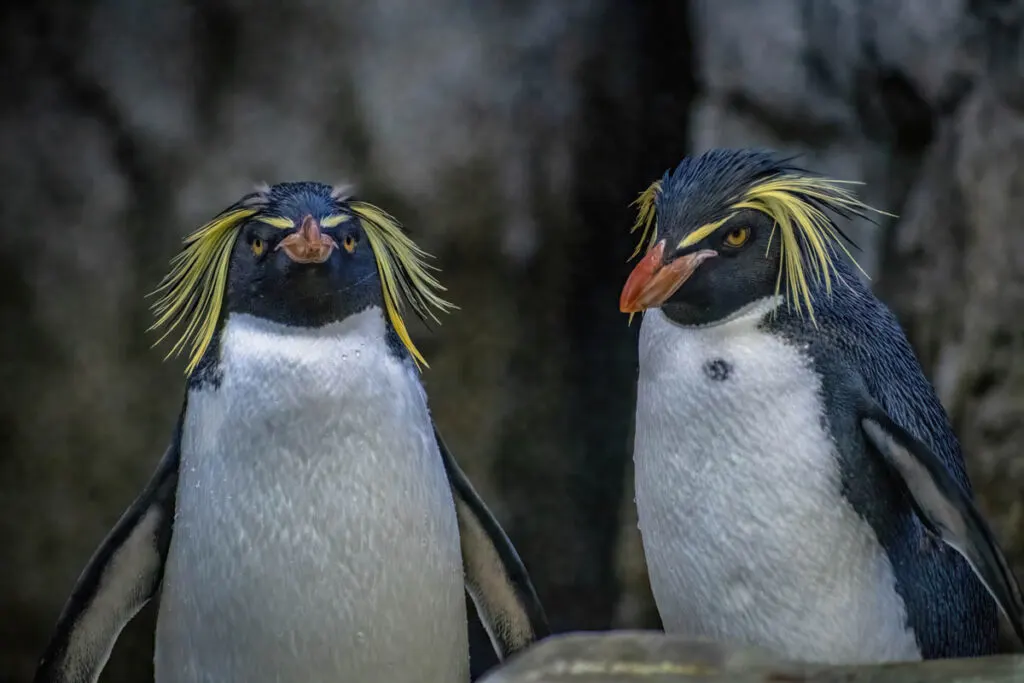
The northern rockhopper penguins (Eudyptes moseleyi) are practically identical to southern rockhopper penguins.
They also have relatively thin yellow plumes, which splay out behind their eyes. Both species of penguins have black crest feathers at the back of their heads.
However, these penguins are slightly larger (6 to 9.5 lbs.) and have longer crest feathers. Aside from slight physical (morphological) differences, northern and southern rockhopper penguins make different calls.
Krill and other crustaceans may make up 90% of their diets. They also eat squid.
Northern rockhopper penguins live between 10 and 20 years and breed on rocky shores and grassy coastal areas in Nouvelle Amsterdam, St. Paul Island, and Tristan da Cunha Islands.
These are highly gregarious penguins, forming large breeding colonies where they wrestle and spare during the breeding season.
They are listed as “endangered,” pollution from oil spills, limited habitat, and competition with humans over food sources (commercial fishing) are significant causes for their decline.
These penguins are also “fleet-footed” over rocks and boulders. They are boisterous, often slapping other birds around with wings, jabbing with their bills, and braying (vocalizing) noisily during the breeding season.
Royal Penguin
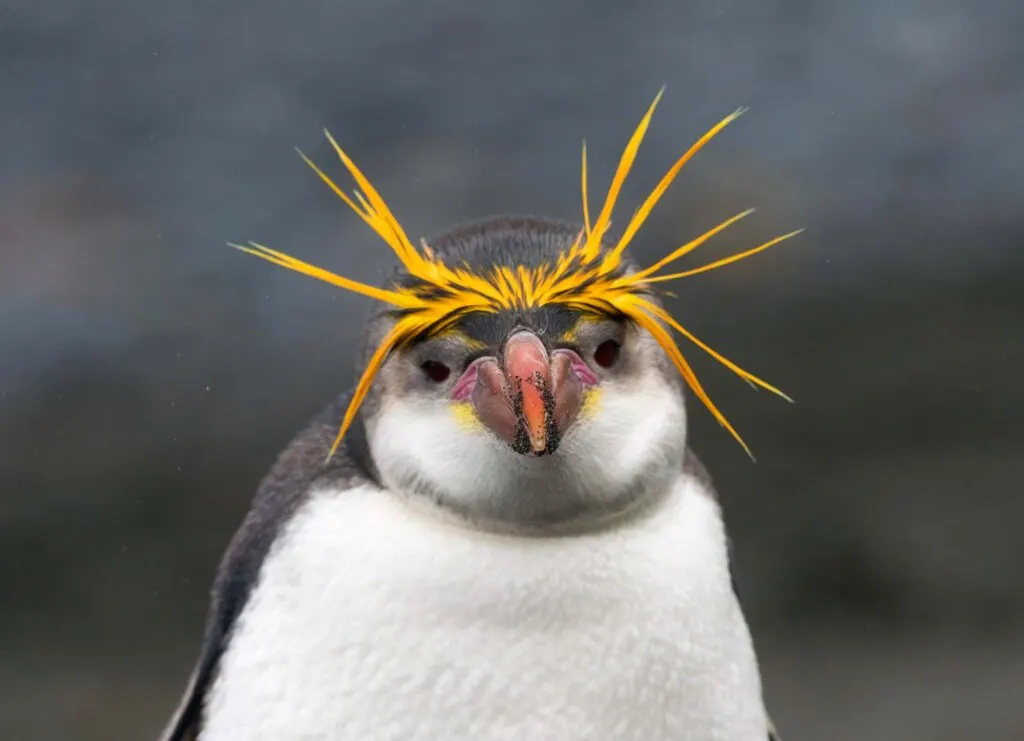
The royal penguin (Eudyptes schlegeli) and macaroni penguins bear a strong resemblance.
Royal penguins are part of the crested penguin types; however, their two yellow-orange plumes join together on top of their head and run backward.
They have a large, thick orange bill, with a white face, chest, and belly. They are black on top of their head, back, and wings. Growing to approximately 28 in, they weigh 9 to 13 lbs. They are some of the largest crested penguins.
Royal penguins feed primarily on krill; however, they also eat other crustaceans, cephalopods, and small fish.
They congregate on Macquarie Island and nearby islets for breeding in large colonies and nest in hollows in the sand, tree/plant-covered slopes, or rocks lined with grass.
These penguins migrate to Australia, New Zealand, and Tasmania. They often inhabit coastal scrub, rocky/pebbled beaches, and pelagic waters when not breeding.
Listed as “vulnerable,” there are roughly 500,000 breeding pairs. However, due to their limited breeding habitat, they are threatened if there is an ecological disaster like pollution or introduced predators.
While fur seals hunt and eat them, elephant seals may accidentally crush them.
Some scientists argue that the royal penguin is a subspecies of the macaroni.
Macaroni Penguin
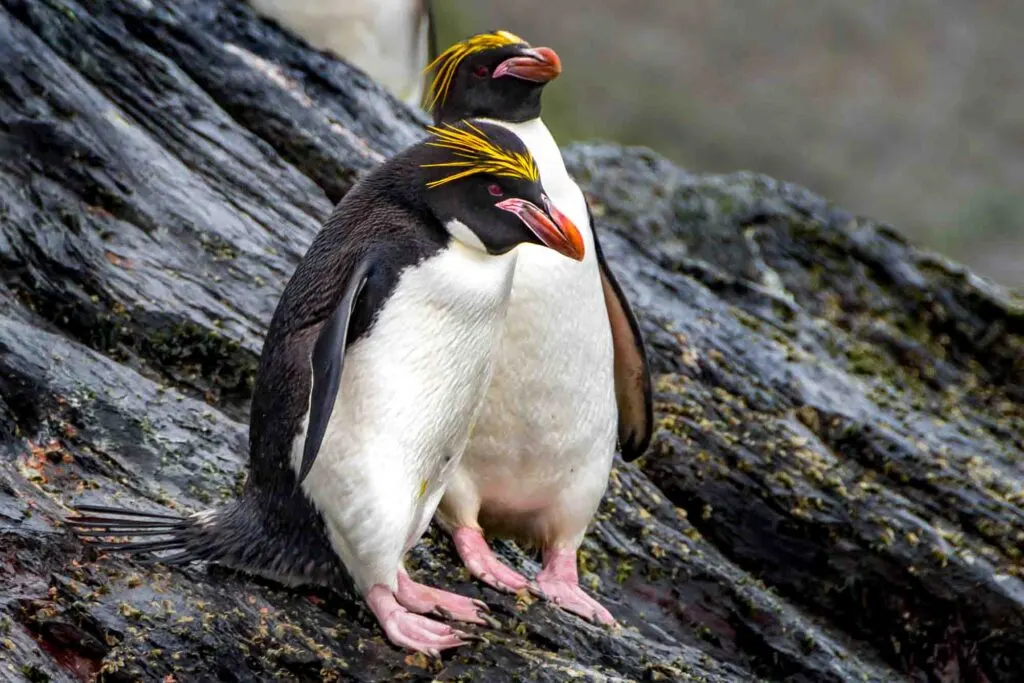
The macaroni penguin (Eudyptes chrysolophus) is a crested penguin closely related to the royal penguin. However, their face is completely black, and while their crest starts in the middle of the forehead, it doesn’t run backward as “neatly.”
Their name originates from a fashion style (flamboyant and over the top) that originated in Europe during the late 1700s and relates to the yellow-orange crest/plume.
They have large red-orange bills with black backs, wings, and heads. Their chests and bellies are white.
Macaroni penguins grow between 27 and 28 in. and weigh 9 to 14 lbs. They eat krill primarily. They also eat cephalopods, other crustaceans, and small fish. While they usually dive between 50 and 230 ft, they may dive to 375 ft while foraging.
Living between 8 and 15 years, these penguins inhabit rocky coastlines and pelagic waters around the Antarctic Peninsula, Antarctic and subantarctic islands, and on Islands off of Chile and Argentina.
Listed as “vulnerable,” there are an estimated 9 million macaroni penguin breeding pairs (the largest population of all penguin species).
They breed in massive colonies, densely packed. Nests are often constructed from pebbles, grass, or on rocks.
Predators include fur seals, leopard seals, and orcas.
Did you enjoy learning more about these types of penguins? Then share this article with your friends so they can learn it too!
